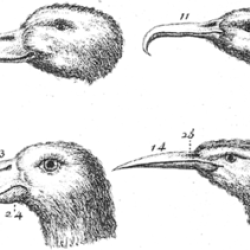Source Institutions
Source Institutions
Add to list Go to activity

In this classic activity, learners investigate natural selection by becoming birds foraging for food on an island. The prey (beans) vary in their coloration such that some blend into the environment better than others. The birds vary in the type of beak they have (plastic forks, spoons and knives). Each season, any prey that survives has a baby bean the same color as the parent. In addition, the most successful birds have a baby with the same beak trait while the least successful birds die. Over several generations, the bird and bean populations shift depending on the environment. [Activity is publicly available through a web crawler capture on Archive.org.]
- 45 to 60 minutes
- 1 to 2 hours
- $10 - $20 per group of students
- Ages 11 - 18
- Activity, Experiment/Lab Activity, Lesson/Lesson Plan, Simulation
- English
Quick Guide
Materials List (per group of students)
- 1 pound of red beans
- 1 pound of black beans (of a similar size and shape as the other beans)
- 1 pound of white beans (of a similar size and shape as the other beans)
- 25 plastic forks
- 25 plastic spoons
- 25 plastic knives
- 30 paper cups
- 1 stopwatch
- 1 whistle
- broom and dustpan for cleanup
- 1 copy of the Bird Beak learner handout for each learner
- 3 copies of the Bird Beak data tables
- 4 clipboards with a pencil/pen tied to each
- masking tape or string to designate the borders of the feeding ground (optional)
Subjects
-
Life Sciences
-
Diversity of Life
- Animals
-
Ecology
- Ecosystems
- Populations
-
Evolution
- Mechanisms of Evolution
-
Heredity and Genetics
- Patterns of Heredity
-
Diversity of Life
-
The Nature of Science
-
The Scientific Process
- Conducting Investigations
- Gathering Data
-
The Scientific Process
Informal Categories
- Animals
- Nature and Environment
Audience
To use this activity, learners need to:
- see
- see color
- read
- be mobile
- touch
Learning styles supported:
- Involves hands-on or lab activities
Other
Components that are part of this resource:
Includes alignment to state and/or national standards:
Includes assesments for student learning:
This resource is part of:
Access Rights:
- Free access
By:
- Salter, Irene
Rights:
- Creative Commons: Non-commercial (by-nc), Irene Salter,
Funding Source:
- Rose Foundation
